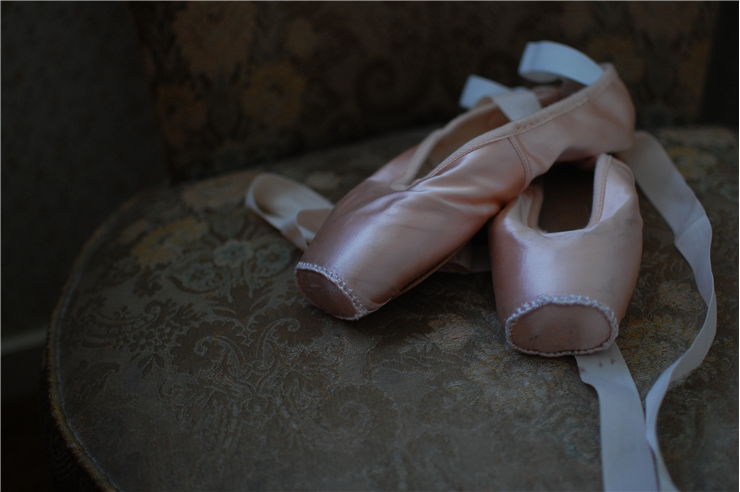Pointe Shoes – History of Ballet Pointe Shoes
The most known dance shoe is pointe shoe. They are used when ballet dancer performs pointe work. They are usually worn by female ballet dancers. En pointe dance is when ballet dancers dance on the tips of their toes. These shoes developed as a need of ballet dancers to dance en pointe for an extended period and as the wish that ballet dancer appears weightless, lightfooted and graceful while jumping and looks lightweight like defying gravity.
History of ballet pointe shoes started when women began to dance ballet in 1681, twenty years after King Louis XIV of France ordered the founding of the Académie Royale de Danse. Pointe shoes of this period originally had heels. The first non-heeled shoe appeared in the mid-18th century when dancer Marie Camargo of the Paris Opéra Ballet performed leaps that would have been hard in conventional shoes of the age with heels.

After the French Revolution, all standard ballet shoes were without heels. These flat-bottomed shoes represent the predecessors of the modern pointe shoes. They were secured to the feet by ribbons and incorporated pleats under the toes which enabled dancers to leap, execute turns, and fully extend their feet.
In 1795, Charles Didelot created the predecessor of classical pointe shoes. He invented the "flying machine" which enabled lifting dancers upward, allowing them to stand on their toes before leaving the ground. After his invention, many choreographers began to look for ways to incorporate more pointe figures into their pieces.
In the 19th century appeared the desire to dance en pointe without the aid of wires. Marie Taglioni, who first danced La Sylphide en pointe, wore shoes with the soles that were made of leather and the sides and toes that were darned to help the shoes, hold their shapes. However, the shoes of this period were not comfortable, and dancers often rely on the strength of their feet and ankles for support.
In the late 19th century in Italy appeared different form of the pointe shoe. These new model had a sturdy, flat platform at the front end of the shoe in comparison with an earlier model that had sharply pointed toe. Pointe shoes of this period become more silent because they were constructed without nails and the soles were only stiffened at the toes.
The first modern pointe shoes appeared in the early 20th-century when Russian ballerina Anna Pavlova inserted toughened leather soles into her shoes and flattened and hardened the toe area to form a box. In this way, shoes gave extra support to feet.
Manufacturers make different models of ballet shoes or custom ballet shoes because ballet dancers have different feet shape, toe length and feet arch flexibility. Most known color for pointe shoes is light pink. Ballet dancer sometimes wears different pointe shoes models for different performance. Aggressive style requires more stiff pointe shoes while lyrical style requires softer pointe shoes.
They are made using turn shoe method where shoes are made inside-out on a last and before finishing turned right-side-out. Lasts can be made to replicate ballerina’s feet.
Ballet dancers have to break in the new ballet pointe shoes to avoid discomfort.
Demi-pointe shoes are very similar to pointe shoes, but they lack hard structure, have no shank, so they are softer. Beginners to pointe technique use them to strengthen feet and ankles.
Dori shoes combine toe box and heel allowing steps from classical ballet and other dance styles.
Elements of ballet pointe shoes are:
- 1. A box – is the front end of the ballet pointe shoes. It supports and encases the ballet dancer’s toes. It is made from layers of fabric and paper glued together or rubber and plastic. It is a rigid and stiff enclosure and flattened platform. Box part of ballet pointe shoes allowed to ballet dancer balance.
- 2. Two ribbons and an elastic band – they are used to secure the shoe to the foot. Ribbons are wrapped around the ankle in overlapping style, then tied in a knot and tucked under the ribbon. They have to be placed custom to dancer’s foot.
- 3. Shank – is the inside of the ballet pointe shoe. It gives support for the arch of the foot and hardens sole from the inside of the pointe shoe. It is made from leather, plastic or glued cardstock. The thickness of the shank determines the flexibility. Standard shoes have a full shank, but its thickness may transition at some parts along its length to achieve different strength.
- 4. Sole – is the bottom of the ballet pointe shoes. It is made from leather glued and reinforced by stitches to the shoe. The sole can be with a smooth surface or scraped to make better traction.
- 5. Fabric cover - often satin, is for aesthetics, decoration, and pleasing look and to conceal the structural elements. It covers the maximum area of the shoe’s visible surface except the sole. The color of ballet pointe shoe is often light pink.
- 6. Accessories – to avoid discomfort ballet dancers wrap tape around toes, wrap lambswool around toes, insert gel toe spacers between toes and put toe pads on toes. This is done to avoid blisters and to pack toes densely.
Pointe shoes will last through ten to twenty hours of wear. Professional ballet dancers will wear it out in one performance. The lifetime of pointe shoes include many factors like fit, breaking-in, technique, usage, foot strength, weight and performance surface.
The lifetime of ballet pointe shoes depends on:
- 1. Shank – it gradually weakens, becomes too soft and loses support
- 2. Box – in time it becomes too soft and loses support
- 3. The exterior fabric – it is exposed to friction against the performance surface, but it doesn’t affect the performance just the aesthetics. Damaged fabric shoes are used in informal practice.
